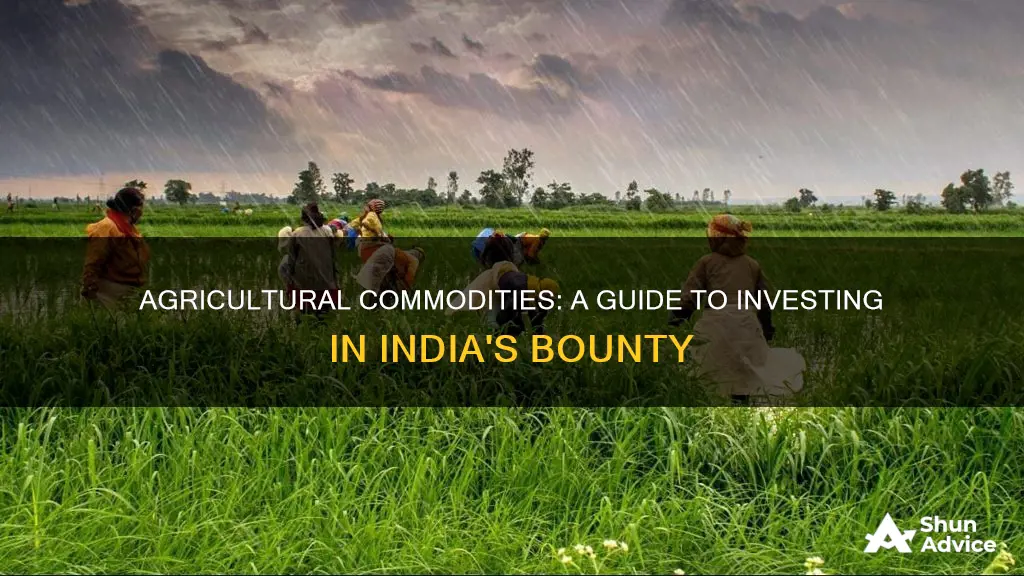
India's agriculture sector is vital to its economy, contributing almost 18.8% to the total Gross Value Added (GVA) in 2021-22. The country is a leading global producer of agricultural commodities such as milk, spices, pulses, tea, cashew, and jute, and ranks second in the production of rice, wheat, oilseeds, fruits, vegetables, sugarcane, and cotton. Investing in agricultural commodities offers a unique opportunity for profitable returns and plays a crucial role in ensuring a stable supply of essential food and raw materials. This sector is dynamic and multifaceted, underpinning the global food supply chain while presenting compelling investment prospects. India's diverse agro-climatic zones, with varying soil types, weather patterns, and crop-growing potential, offer a range of investment avenues.
Agricultural commodities trading involves the exchange of raw products, categorized into soft commodities (crops and livestock) and hard commodities (metals and energy resources). It primarily occurs on centralized platforms called agricultural commodity exchanges, which standardize commodities and establish transparent contracts.
To invest in agricultural commodities in India, one must carefully plan and follow a systematic approach. This includes gaining a deep understanding of the market, choosing a commodity based on knowledge, risk tolerance, and market conditions, selecting a reliable trading platform, and developing a robust trading strategy that incorporates risk management techniques.
India has several top-traded agricultural commodities, including rice, wheat, cotton, soybeans, spices, sugar, and guar seed. The country's agricultural sector is expected to grow further, with increasing investment in infrastructure, self-sufficiency in pulses and genetically modified crops, and government initiatives such as the Digital Agriculture Mission and the Production-Linked Incentive Scheme for the Food Processing Industry.
| Characteristics | Values |
|---|---|
| Agricultural commodities trading | Exchange of raw products sourced primarily from the agricultural sector |
| Categories | Soft commodities (crops and livestock) and hard commodities (metals and energy resources) |
| Trading platforms | Agricultural commodity exchanges, such as the Indian Multi Commodity Exchange (MCX) and the National Commodity and Derivatives Exchange (NCDEX) |
| Investment options | Physical ownership, futures contracts, individual securities, mutual funds, ETFs, ETNs, alternative investments |
| Top traded commodities | Rice, wheat, cotton, soybeans, spices, sugar, guar seed |
| Advantages | Diversification, hedging, profit potential, physical ownership, global market access, inflation hedge, environmental impact |
| Influencing factors | Weather conditions, global demand, government policies, currency fluctuations, pest and disease outbreaks, transportation and infrastructure, speculation |
What You'll Learn

Understanding the market and commodity exchanges
Agricultural commodities trading involves the exchange of raw products sourced primarily from the agricultural sector. These commodities are divided into two main groups: soft commodities and hard commodities. Soft commodities include crops and livestock, while hard commodities consist of metals and energy resources extracted from the earth.
Agricultural commodities trading predominantly occurs on agricultural commodity exchanges, which act as centralized platforms where buyers and sellers converge to facilitate the trading of these goods. These exchanges standardize commodities and establish contracts to promote transparency and equitable trading. The Indian Multi Commodity Exchange (MCX) and the National Commodity and Derivatives Exchange (NCDEX) are two of the major exchanges in India. While MCX deals in a wide range of products, NCDEX primarily focuses on agro-based commodities.
Before investing in agricultural commodities, it is crucial to gain a deep understanding of the market. Familiarize yourself with various commodities, trading strategies, and the functioning of these exchanges. Analyze factors that influence commodity prices, such as weather conditions, global demand, government policies, currency fluctuations, pest and disease outbreaks, transportation, and infrastructure.
India has a diverse range of commodities actively traded on its agricultural commodity exchanges. Some of the top agro commodities include rice, wheat, cotton, soybeans, spices, sugar, and guar seed. India's vast arable land, divided into 15 agro-climatic zones, along with its favorable weather patterns and crop-growing potential, contribute to its strong position in agricultural production and trading.
By investing in agricultural commodities, participants can benefit from diversification, hedging against price fluctuations, profit potential, physical ownership, global market access, and an inflation hedge. Additionally, investing in sustainable and ethical agricultural commodities can promote responsible farming practices.
To start trading in agricultural commodities, follow these steps:
- Educate yourself about the market, commodities, trading strategies, and exchange functioning.
- Select the specific commodity you wish to trade based on your knowledge, risk tolerance, and market conditions.
- Choose a reliable trading platform or brokerage that offers access to your commodity of interest.
- Develop a robust trading strategy that includes risk management, entry and exit points, and the types of contracts you'll trade (futures or options).
- Implement risk management techniques, such as stop-loss orders, to protect your capital from potential volatility.
- Execute your trades according to your strategy, staying informed about market news and data that can impact commodity prices.
- Regularly monitor your trades and be prepared to adjust your strategy as market conditions evolve. Flexibility is key to long-term success.
Understanding Investment Management: The Distribution Factor
You may want to see also

Choosing a commodity
Understanding Soft and Hard Commodities
Firstly, it is important to understand the distinction between soft and hard commodities. Soft commodities refer to agricultural products that are grown, including crops and livestock. Examples of soft commodities include wheat, soybeans, coffee, rice, and cotton. On the other hand, hard commodities are those that are extracted from the earth, such as metals and energy resources. This category includes metals like copper, zinc, aluminium, and nickel, as well as energy products like crude oil and natural gas.
Market Dynamics and Influencing Factors
When choosing a commodity, it is essential to consider the dynamics of the market and the factors that influence commodity prices. These factors include weather conditions, global demand, government policies, currency fluctuations, pest and disease outbreaks, transportation and infrastructure, and speculation by investors and speculators. For example, weather events like droughts, floods, or extreme temperatures can impact crop yields and quality, thereby affecting the supply and prices of agricultural commodities.
Risk Tolerance and Market Conditions
Your choice of commodity should align with your risk tolerance and the current market conditions. Some commodities may be more volatile than others due to factors such as government policies, supply and demand dynamics, or global events. For instance, agricultural products are often more susceptible to factors like monsoons, cropping patterns, and irrigation, making them less amenable to long-term investment strategies.
Diversification and Hedging
Consider the benefits of diversification and hedging when selecting a commodity. Investing in agricultural commodities can provide diversification to your portfolio, as these assets often exhibit low correlations with traditional financial markets. Additionally, agricultural commodity markets enable producers and consumers to hedge against price fluctuations, reducing their exposure to market risk.
Long-Term Investment Potential
Evaluate the long-term investment potential of different commodities. Some commodities, like precious metals (gold, silver, platinum, and palladium), are considered safe havens during economic uncertainty and offer a hedge against inflation and currency shocks. Base metals like copper, zinc, and aluminium may be more suitable for medium-term opportunities, while energy products like oil can be highly volatile due to various factors and are typically favoured for shorter-term investments.
Personal Knowledge and Interest
Lastly, choose a commodity that aligns with your knowledge and interests. Gaining a deep understanding of the market, familiarizing yourself with various commodities, and staying updated on market news and data are crucial steps in the investment process. Selecting a commodity that you are knowledgeable about and comfortable with can help you make more informed investment decisions.
In conclusion, choosing a commodity requires careful consideration of various factors, including market dynamics, risk tolerance, investment goals, and personal interests. By understanding the unique characteristics and influencing factors of different commodities, you can make a more informed decision that aligns with your investment strategy and financial objectives.
Managing Personal Investments: Strategies for Success
You may want to see also

Selecting a trading platform
When selecting a trading platform for agricultural commodities in India, it is essential to opt for a reliable platform that provides access to a diverse range of commodities. The Indian Multi Commodity Exchange (MCX) and the National Commodity and Derivatives Exchange (NCDEX) are two prominent options. While MCX focuses on bullion, mineral commodities, and agro-based products, NCDEX specializes in agro-based commodities, offering 25 products in this category.
If you are specifically interested in agro products, NCDEX might be a better choice. However, for those seeking a broader range of commodities, including energy, base metal, and precious metals, MCX could be preferable. It is worth noting that MCX is considered stronger in these areas compared to NCDEX.
In addition to these two major exchanges, online brokerage platforms, such as Enrich Money, can also provide access to agricultural commodity trading. These platforms often offer research tools and resources to help you make informed trading decisions.
When choosing a trading platform, it is crucial to consider the specific commodities you wish to trade, your risk tolerance, and the platform's reliability and reputation. Additionally, look for platforms that provide educational resources and market insights to enhance your trading strategies.
Remember to evaluate the fees, commissions, and other costs associated with each platform, as these can impact your overall returns. Also, ensure that the platform is regulated and offers adequate security measures to protect your investments.
Savings or Investing: Where Should Your Money Go?
You may want to see also

Developing a trading strategy
- Risk Management: The potential volatility in the agricultural commodities market necessitates the implementation of risk management techniques. Setting stop-loss orders can help limit potential losses and safeguard your capital. It is important to be prepared for adverse events such as droughts, floods, pest outbreaks, or changes in government policies that can impact your trades.
- Market Understanding: Familiarize yourself with various commodities, trading strategies, and the functioning of agricultural commodity exchanges in India. Understand the factors that influence commodity prices, such as weather conditions, global demand, currency fluctuations, and transportation infrastructure.
- Commodity Selection: Choose the agricultural commodity you wish to trade based on your knowledge and risk tolerance, as well as current market conditions. Diversify your portfolio by selecting commodities with low correlations to traditional financial markets. Consider commodities like wheat, soybeans, coffee, cotton, rice, or spices like black pepper and cardamom, which are actively traded in India.
- Trading Platform: Access a reliable agricultural commodities trading platform or brokerage that offers the specific commodities you are interested in. Ensure the platform provides real-time market data and tools to facilitate your trading strategy.
- Trading Approach: Decide whether you want to take a long-term or short-term approach to trading. Consider using futures contracts, which allow you to buy or sell commodities at predetermined prices on future dates. Alternatively, you can invest in commodities for the long term, but this may require rolling over futures contracts periodically by paying a premium.
- Trade Execution and Monitoring: Once you have developed your strategy, execute your trades accordingly. Stay up-to-date with market news and data that could impact commodity prices. Continuously monitor your trades and be prepared to adjust your strategy as market conditions change. Flexibility and responsiveness are key to long-term success in the volatile agricultural commodities market.
Key Objectives of Investment Management Strategies
You may want to see also

Implementing risk management
Risk management is a crucial aspect of investing in agricultural commodities in India. Here are some detailed instructions on implementing risk management strategies:
Setting Stop-Loss Orders:
Setting stop-loss orders is a vital risk management technique. This involves placing an order to sell a commodity if it reaches a certain price, thereby limiting potential losses. In volatile markets like agricultural commodities, this can safeguard your capital. For example, if you buy gold and set a stop-loss order at a certain price level, your trade will be automatically executed if the price falls to that level, preventing further losses.
Diversification:
Diversifying your investment across different agricultural commodities can help manage risk. By spreading your capital across various commodities, such as wheat, soybeans, coffee, cotton, or spices, you reduce the impact of any single commodity's price movements. This strategy is effective as agricultural commodities often exhibit low correlations with each other due to their diverse nature and varying supply-demand dynamics.
Hedging:
Hedging is a risk management strategy that involves taking an offsetting position in a related commodity or financial instrument to protect against adverse price movements. For instance, if you are long on a particular commodity, you could short its futures to lock in a selling price and protect against potential declines in that market. This strategy is commonly used by producers and consumers to reduce their exposure to market risk.
Monitoring and Adjusting:
Continuously monitor your trades and be prepared to adjust your strategy as market conditions change. This may involve setting price alerts to notify you of significant price movements or regularly reviewing news and data that could impact commodity prices. Being responsive and flexible is vital for long-term success in the volatile agricultural commodities market.
Choosing the Right Trading Platform:
Select a reliable trading platform or brokerage that offers risk management tools and resources. Some platforms may provide features like stop-loss orders, trailing stops, or risk management calculators to help you make informed decisions. Additionally, consider the platform's liquidity, as this can impact your ability to enter and exit trades at desired prices, especially during periods of high volatility.
Understanding Market Dynamics:
Gain a deep understanding of the factors influencing agricultural commodity prices, such as weather conditions, global demand, government policies, currency fluctuations, pest and disease outbreaks, and transportation infrastructure. By comprehending these dynamics, you can make more informed decisions and adjust your risk management strategies accordingly.
Monitoring Government Policies:
Government interventions, including subsidies, tariffs, and import/export restrictions, can significantly impact agricultural commodity prices. Stay updated on relevant policies and their potential effects on the market. For instance, if the government announces export restrictions on a particular commodity, it may lead to an increase in prices due to reduced supply.
Speculation and Market Sentiment:
Be mindful of the influence of speculators and investors on market prices. Their actions may not always align with the fundamental dynamics of supply and demand. Monitor market sentiment and keep an eye on speculative activities, especially from large institutional investors, as they can impact price movements in the short term.
Environmental and Climate Factors:
Consider the impact of environmental and climate factors, such as droughts, floods, or extreme temperatures, on crop yields and quality. These factors can affect the supply of agricultural commodities and, consequently, their prices. Stay informed about climate patterns and their potential effects on the production of specific commodities.
Storage and Delivery Considerations:
When investing in physical commodities, consider the storage and delivery aspects. Taking physical delivery of commodities like gold or agricultural produce requires secure storage facilities and may incur additional costs. Understand the implications of taking delivery versus trading in futures or options, where you can decide about delivery before expiry.
Long-Term Perspective:
While short-term trading is common in agricultural commodities, consider taking a long-term view. Commodities often exhibit long bull and bear cycles. For example, gold has historically had major rallies lasting several years. By taking a long-term perspective, you can aim to capture these longer-term trends and reduce the impact of short-term volatility.
Morgan Stanley Investment Management: Institutional Investor Status Explained
You may want to see also
Frequently asked questions
First, gain a deep understanding of the market, commodities, and trading strategies. Next, choose a commodity that suits your knowledge, risk tolerance, and current market conditions. Then, select a reliable trading platform or brokerage that offers access to your chosen commodity. Develop a robust trading strategy that includes risk management, entry and exit points, and the types of contracts you'll trade. Implement risk management techniques such as stop-loss orders to protect your capital. Execute your trades according to your strategy, and regularly monitor and adjust your strategy as market conditions change.
Investing in agricultural commodities offers several benefits. It provides diversification as these assets often exhibit low correlations with traditional financial markets. It also allows producers and consumers to hedge against price fluctuations. Traders can profit from price movements in both rising and falling markets. Additionally, some traders prefer physical ownership of commodities, and agricultural commodities are traded globally, offering international diversification. Many agricultural commodities also serve as a hedge against inflation.
India has a rich history of agricultural commodity trading, and a diverse range of commodities are actively traded on exchanges. Some of the top commodities include rice, wheat, cotton, soybeans, spices, sugar, and guar seed.
The prices of agricultural commodities are influenced by various factors, including weather conditions, global demand, government policies, currency fluctuations, pest and disease outbreaks, transportation and infrastructure, and speculation.
Agricultural commodities trading plays a vital role in ensuring a stable supply of essential food and raw materials globally. It also offers opportunities for profitable investments, making it a dynamic and multifaceted sector that underpins the global food supply chain.







